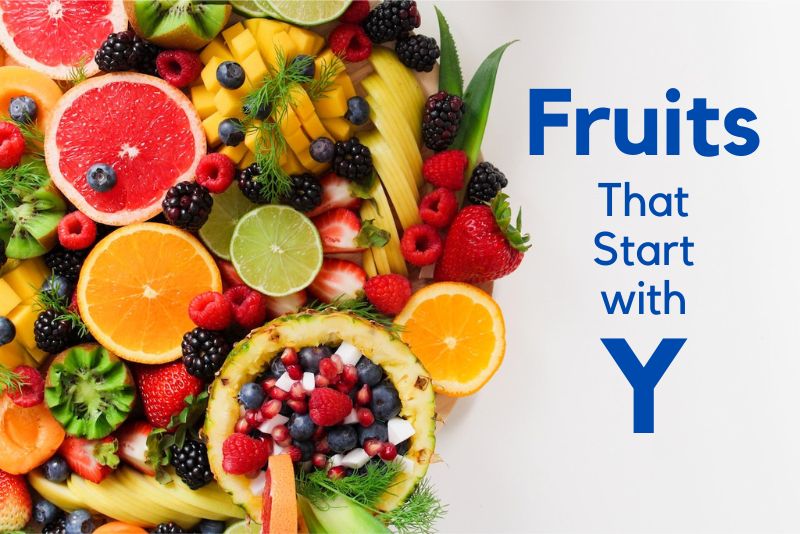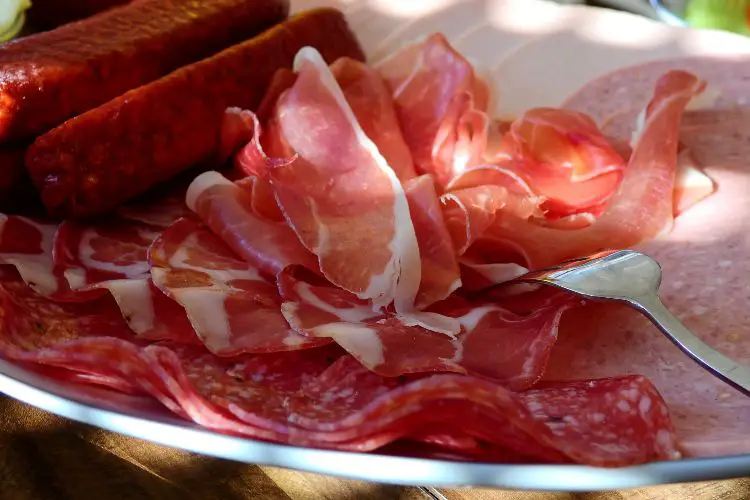Fruits That Start with Y (Complete List of 25+ Fruit Names)
Welcome to the world of fruits that start with the letter “Y”! While this might be a less familiar group, it is still home to some intriguing and delicious fruits. From exotic citrus varieties to unique berries and roots, these fruits offer a range of flavors, textures, and culinary possibilities.
Explore the tangy zest of the yuzu, the sweetness of the yumberry, or the starchy goodness of yucca. Let’s dive into this lesser-known realm and discover the delightful fruits beginning with “Y.” Get ready for a delightful journey through a lesser-explored corner of the fruit kingdom!
List of Fruits Starting with Y
Ya Pear
The Ya pear, also known as the Chinese white pear, is a crisp and juicy fruit with a sweet flavor. It has a yellow-green skin and a creamy white flesh. Ya pears are popular in Chinese cuisine and are often enjoyed fresh or used in salads and desserts. They are rich in dietary fiber, vitamin C, and antioxidants.
Yaca
Yaca, also known as jackfruit, is a tropical fruit with a distinctive appearance and flavor. It is the largest tree-borne fruit in the world and can reach impressive sizes. Yaca has a spiky green or yellowish skin and a sweet, fragrant flesh. It is commonly used in savory dishes as a meat substitute and is also enjoyed in desserts and smoothies.
Yali Pear
The Yali pear is a variety of Asian pear that originated in China. It has a round shape with a yellow-green skin and a crisp, juicy flesh. Yali pears have a refreshing sweet and slightly tart taste. They are often eaten fresh and are a popular ingredient in salads, desserts, and preserves.
Yams
Yams are starchy root vegetables that are popular in many cuisines around the world. They come in various colors, such as orange, purple, or white, and have a sweet and nutty flavor. Yams are highly nutritious and are a good source of fiber, potassium, and vitamin C. They can be baked, boiled, roasted, or used in soups and stews.
Yangmei
Yangmei, also known as waxberry or Chinese bayberry, is a small round fruit native to East Asia. It has a thin red or purple skin and a juicy, sweet-tart flesh. Yangmei fruits are often eaten fresh and are also used in making preserves, jams, and alcoholic beverages. They are rich in antioxidants and vitamin C.
Yellow Apple
Yellow apples are a variety of apple that have a yellow or golden skin color. They come in different flavors, ranging from sweet to slightly tart. Yellow apples are a good source of dietary fiber and vitamin C. They can be eaten fresh, used in cooking, or made into applesauce and apple pies.
Yellow Dragon
Yellow dragon fruit, also known as yellow pitaya, is a tropical fruit with a vibrant yellow exterior and white or yellow flesh speckled with small black seeds. It has a mildly sweet taste and a texture similar to kiwi fruit. Yellow dragon fruit is enjoyed fresh or used in smoothies, salads, and desserts. It is packed with nutrients and antioxidants.
Yellow Grapes
Yellow grapes are a variety of grapes that have a yellow or golden hue. They are known for their sweet and juicy flavor. Yellow grapes can be eaten fresh, used in fruit salads, or made into wine and juice. They are a good source of vitamins, minerals, and antioxidants.
Yellow Guava
Yellow guava is a tropical fruit with a yellow skin and sweet, fragrant flesh. It has a unique flavor that combines sweetness with a hint of tartness. Yellow guava is enjoyed fresh and is also used in juices, jams, and desserts. It is rich in vitamin C and dietary fiber.
Yellow Himalayan Raspberry
The Yellow Himalayan Raspberry is a unique variety of raspberry with golden-yellow berries. It is a wild fruit found in the Himalayan region and is known for its sweet and tangy flavor. The berries are rich in antioxidants, vitamins, and minerals, making them a nutritious choice. These raspberries can be enjoyed fresh, used in jams and jellies, or added to desserts and baked goods.
Yellow Passion
Yellow passion fruit, also known as yellow granadilla, is a tropical fruit with a vibrant yellow skin and a tangy, sweet flavor. It has a juicy and aromatic pulp filled with black seeds. Yellow passion fruit is commonly used to make refreshing juices, cocktails, and desserts. It is also rich in vitamin C, fiber, and antioxidants.
Yellow Pear Tomato
Yellow pear tomatoes are small, teardrop-shaped fruits with a bright yellow color. They have a sweet and tangy flavor that is both juicy and refreshing. Yellow pear tomatoes are popular for their unique shape and are often used in salads, salsas, and as a garnish. They add a pop of color and flavor to dishes and are a favorite among gardeners due to their prolific nature.
Yellow Plum
Yellow plums are a variety of plums with a vibrant yellow skin and sweet, juicy flesh. They have a slightly tart taste and a delightful aroma. Yellow plums can be eaten fresh, used in fruit salads, or made into jams, jellies, and pies. They are a good source of vitamins, minerals, and dietary fiber.
Yellow Sapote
Yellow sapote, also known as canistel, is a tropical fruit with a creamy, custard-like texture and a sweet flavor. It has a yellow-orange flesh and a thin skin. Yellow sapote is often enjoyed fresh or used in desserts, ice creams, and smoothies. It is high in vitamins A and C, as well as fiber.
Yellow Squash
Yellow squash is a type of summer squash that has a vibrant yellow color and a mild flavor. It has a tender texture and can be cooked in various ways, including sautéing, grilling, or baking. Yellow squash is a versatile vegetable that can be used in soups, stir-fries, casseroles, or enjoyed on its own as a side dish. It is low in calories and a good source of vitamins A and C.
Yellow Strawberry
Yellow strawberries are a unique variety of strawberries that have a pale yellow color instead of the typical red. They have a sweet and slightly tangy flavor and are often described as having a tropical taste. Yellow strawberries are enjoyed fresh, used in desserts, or added to fruit salads for a colorful twist. They are a good source of vitamin C and antioxidants.
Yellow Watermelon
Yellow watermelon is a refreshing fruit with a yellow or pale orange flesh and a sweet, juicy taste. It has a milder flavor compared to the traditional red watermelon but is equally thirst-quenching. Yellow watermelon can be enjoyed on its own, used in fruit salads, or blended into refreshing beverages. It is hydrating and packed with vitamins A and C.
Yemenite Citron
The Yemenite citron, also known as the Etrog, is a citrus fruit with a thick, bumpy skin and a fragrant aroma. It is primarily used in religious ceremonies and is considered sacred in Jewish tradition. Yemenite citrons have a tart and tangy taste and are rarely eaten raw due to their strong flavor. They are often used in cooking, baking, and making preserves.
Yew
Yew is an evergreen tree that produces small red berries. While the fleshy part of the fruit is not edible and can be toxic, the seeds inside the berries are mildly poisonous as well. However, yew trees hold cultural significance and are valued for their ornamental beauty and use in landscaping. Additionally, the yew tree has historical significance and has been associated with myths and legends.
York Imperial Apple
The York Imperial apple is a classic variety known for its crisp texture and balanced flavor. It has a yellow-green skin with red blushes and is often used for baking, cider making, and eating fresh. York Imperial apples have a sweet-tart taste and are juicy, making them a popular choice among apple lovers. They are versatile and can be enjoyed in various culinary applications.
Young Mango
Young mango refers to an unripe mango that is harvested when it is still green and firm. These mangoes have a tangy and slightly sour taste, different from the sweet flavor of ripe mangoes. They are often used in savory dishes, salads, chutneys, and pickles. Young mangoes are a good source of vitamins and minerals, including vitamin C and dietary fiber.
Youngberry
The youngberry is a cross between a blackberry and a dewberry. It has a deep purple color and a sweet-tart flavor. Youngberries are larger than blackberries and have a juicy texture. They are enjoyed fresh, used in baking, jams, and desserts, or incorporated into smoothies and sauces. Youngberries are rich in antioxidants and vitamin C.
Yucca
Yucca is a plant with long, sword-shaped leaves and edible tuberous roots. The yucca root, also known as cassava, is starchy and used in various cuisines around the world. It can be boiled, mashed, fried, or made into flour. Yucca root is a staple food in many tropical regions and is a good source of carbohydrates. The plant itself is also valued for its ornamental appeal and drought-resistant nature.
Yumberry
Yumberry, also known as Chinese bayberry, is a small fruit with a glossy red skin and a sweet-tart taste. It has a juicy flesh and a unique flavor that combines sweetness with hints of acidity. Yumberry is often eaten fresh or used in making juices, jams, and alcoholic beverages. It is rich in antioxidants, vitamins, and minerals.
Yunnan Hackberry
Yunnan hackberry is a fruit that grows on the hackberry tree, native to China. It has a small size and a dark purple or black color. Yunnan hackberries have a sweet and tangy taste with a hint of bitterness. They are enjoyed fresh or used in making jams, jellies, and wines. Yunnan hackberries are a good source of antioxidants and fiber.
Yuzu
Yuzu is a citrus fruit native to East Asia, known for its aromatic fragrance and tart flavor. It has a bumpy yellow skin and a small size. Yuzu is often used as a flavoring agent in cooking, particularly in Japanese cuisine. Its juice and zest are used in sauces, dressings, desserts, and beverages. Yuzu is rich in vitamin C and adds a unique citrusy touch to dishes.
In conclusion, the world of fruits that start with the letter “Y” presents a fascinating array of flavors, textures, and culinary experiences. From the tangy zing of the yuzu to the sweet juiciness of the yumberry, these fruits offer a unique and delightful twist to our taste buds.
Whether it’s the tropical allure of the yaca or the starchy versatility of yucca, each fruit brings its own distinct characteristics to the table. Exploring the fruits that begin with “Y” opens up a whole new world of culinary possibilities and adds a touch of adventure to our fruit experiences.
So, next time you come across a fruit beginning with “Y,” embrace the opportunity to savor something extraordinary and expand your fruit horizons.



